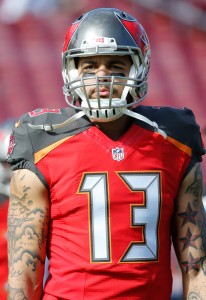Extension Candidate: Quentin Lake
While it didn’t get done in the rush before the start of the regular season, an extension for Rams defensive back Quentin Lake should absolutely be on the table. Playing in the versatile ‘star’ position for Los Angeles in 2024, Lake has made himself an indispensable part of the team’s secondary. 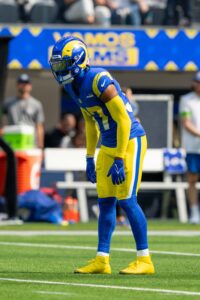
Playing mostly on special teams as a sixth-round rookie in 2022, Lake found a bigger role on defense as his sophomore campaign progressed. A safety during his time at UCLA, Lake began seeing more reps on the Rams defense as a slot corner, splitting time in the role with cornerback Cobie Durant. His role got bigger as the season went on, with Lake getting some starts and increased playing time in the back half of the year.
In 2024, he was named a full-time starter for the Rams. He began the year starting at safety and coming down into the slot for sub packages with an extra defensive back while John Johnson covered his safety spot. When Johnson went on injured reserve with a shoulder injury, third-round rookie Kamren Kinchens became the first safety off the bench. Kinchens struggled early on, and Lake was depended on to hold down the safety position. The Rams slowly gained confidence in Kinchens and began to give him more run at safety, allowing Lake to exercise a more versatile role once again.
Lake appeared all over the field in 2024. Out of 1,207 snaps played on defense, Lake played 511 (42%) in the slot, 398 (33%) at safety, and 244 (20%) in the box. Part of his effectiveness in roaming around the field is due, in part, to his superior run defense, which graded second only to Defensive Rookie of the Year Jared Verse on the Rams defense last year, according to Pro Football Focus (subscription required). For all his work around the field, Lake finished his 2024 campaign second on the team with 111 total tackles.
The types of players Lake most resembles are the versatile safeties like Budda Baker and Derwin James. He’s not quite on the level of those All-Pros, so he probably won’t garner anything near the $18MM-$19.13MM those two are averaging on their current deals. If Los Angeles wants to lock Lake down long-term, knowing how important a role he played in 2024, Lake could even encroach a double-digit average.
There’s currently a gap between Jaguars safety Darnell Savage (three-year, $21.75MM) and Eagles safety C.J. Gardner-Johnson (three-year, $27MM), and anywhere in that gap would make a lot of sense to me. With the season underway, any deal might have to wait for the offseason, but if the Rams want to give Lake peace of mind as he plays out the season on a contract year, finding time to extend him well before free agency might be a good idea.
Extension Candidate: Courtland Sutton
As the Broncos have rebounded from their disastrous 2022 situation, some of the key players to help them climb out of that hole are entering contract years. Nik Bonitto is a traditional extension candidate, coming off a breakout season ahead of the final year of his rookie contract, while Zach Allen jumped a level ahead of his age-28 season. A significant raise will be necessary for the Broncos to keep the ascending interior D-lineman on a third contract.
Denver, however, has a homegrown player residing as a more interesting extension candidate. Courtland Sutton carries a few unusual markers along his journey to another extension case. Even though Bonitto and Allen qualify as higher-value players due to their ages, Sutton stands as a pivotal piece considering the Broncos’ plan on offense. The former John Elway draftee has waited patiently for a deal, reporting to both OTAs and minicamp after skipping some offseason work while pursuing a raise last year. But he looks to have seen the younger defenders leapfrog him in Denver’s extension queue.
 Sutton is going into his age-30 season, and he carries an atypical resume for a No. 1 receiver. The 2018 second-round pick’s two 1,000-yard seasons are spaced five years apart. He helped build an initial extension candidacy by eclipsing 1,000 yards in 2019. That 1,112-yard season still stands as Sutton’s career high; it came with Joe Flacco, Brandon Allen and a rookie-year Drew Lock making starts. A 2020 ACL tear paused Sutton’s ascent, and Denver’s QB quagmire lowered the receiver’s ceiling for an extended stretch.
Sutton is going into his age-30 season, and he carries an atypical resume for a No. 1 receiver. The 2018 second-round pick’s two 1,000-yard seasons are spaced five years apart. He helped build an initial extension candidacy by eclipsing 1,000 yards in 2019. That 1,112-yard season still stands as Sutton’s career high; it came with Joe Flacco, Brandon Allen and a rookie-year Drew Lock making starts. A 2020 ACL tear paused Sutton’s ascent, and Denver’s QB quagmire lowered the receiver’s ceiling for an extended stretch.
As the Broncos assembled a low-octane Teddy Bridgewater offense, Sutton and Jerry Jeudy became info-graphic fodder due to Aaron Rodgers‘ interest in being traded to Denver in 2021. The Packers held onto the reigning MVP that year and in 2022, leading the Broncos to their blockbuster Russell Wilson trade. That move brought a spectacular failure, as an overmatched Nathaniel Hackett grounded Denver’s offense to 32nd in 2022. Sean Payton elevated Wilson back to respectability in 2023, however, and that season effectively launched Sutton’s second extension campaign.
Wilson’s 26-touchdown pass, eight-interception season ended ugly, with a contract-based benching taking place. But Wilson-to-Sutton became the team’s most notable connection since the Peyton Manning days; the 6-foot-4 WR totaled 10 TD receptions, displaying a penchant for acrobatic grabs. Sutton then submitted a second 1,000-yard season, being a linchpin on a 2024 offense bereft of other reliable pass catchers. This helped Sutton post a 1,081-yard 2024 season, boosting Bo Nix to 29 TD passes — the second-most by a rookie QB in NFL history.
So much happened between the Rodgers rumors and Nix’s rookie season, though. Sutton signed a four-year, $60MM extension days after Tim Patrick‘s three-year, $30MM deal. While injuries dogged Patrick in the years that followed, Sutton remained a productive starter. Being an Elway-era draftee extended under George Paton, Sutton became a trade-rumor mainstay during Payton’s initial months on the job. The Broncos listened closely on Sutton and Jeudy during the 2023 offseason, aiming for a second-round pick for Sutton and a first for Jeudy. Nothing on that level emerged, but the Ravens came close to acquiring Sutton — before pivoting to Odell Beckham Jr.‘s $15MM guarantee.
Denver declined a Jeudy offer that included third- and fifth-round picks before the 2023 deadline, holding onto Sutton as well. That Jeudy decision became a mistake, as the team both sold low in March 2024 (fifth- and sixth-round picks) before seeing him post a Pro Bowl season in Cleveland. Jeudy’s departure solidified Sutton’s WR1 standing, to the point the Broncos declined a third-round pick from the 49ers during the summer 2024 Brandon Aiyuk saga. Sutton more than doubling any other Broncos pass catcher in yardage last season strengthened his extension case.
 Missing out on Emeka Egbuka in the draft, the Broncos did not address the receiver position until Round 3 (Pat Bryant). The Illinois prospect’s 4.61-second 40-yard dash time docked his value, and while Marvin Mims has flashed, the Broncos have mostly deployed him as a gadget cog on offense. The team’s 2024 rookies (Devaughn Vele, Troy Franklin) also appear role players, even if Vele’s skillset resembles Sutton’s (Vele is also set to turn 28 before year’s end, complicating the second-year player’s long-term NFL future).
Missing out on Emeka Egbuka in the draft, the Broncos did not address the receiver position until Round 3 (Pat Bryant). The Illinois prospect’s 4.61-second 40-yard dash time docked his value, and while Marvin Mims has flashed, the Broncos have mostly deployed him as a gadget cog on offense. The team’s 2024 rookies (Devaughn Vele, Troy Franklin) also appear role players, even if Vele’s skillset resembles Sutton’s (Vele is also set to turn 28 before year’s end, complicating the second-year player’s long-term NFL future).
Everything since the 2023 season has boosted Sutton’s stock, but finding a price may be proving tricky. The Broncos agreed to only an incentive package with Sutton last year, telling his camp 2025 would be the window for true extension talks. We are here now, and nothing has transpired since Sutton labeled the 2025 talks positive in April. Denver completed summer extensions with Patrick Surtain and Quinn Meinerz last year; Sutton drama could resurface if no deal emerges this summer.
It would surprise if the Broncos revisited trade talks in the event they could not come to terms with Sutton before Week 1. The SMU product remains valuable due to the dearth of proven WR help ahead of Nix’s second season.
Finding contractual comps does prove difficult. Mike Evans and Davante Adams signed similar deals — two years, $41MM (Evans) and 2/44 (Adams) — while Calvin Ridley‘s resume did not match Sutton’s ahead of a four-year, $92MM Titans deal. Ridley signed that contract months before his 30th birthday, though his standing as last year’s top WR free agent — after the Tee Higgins and Michael Pittman Jr. tags — boosted his value. Evans and Adams are much more accomplished players, both of whom also being more than two years older.
Jeudy signed a Browns-friendly extension (three years, $52.5MM), but it came after the Broncos’ QB struggles suppressed his stats. Sutton is in a similar boat, but after being tied to an AAV ($15MM) that sits 25th at the position — following market booms in 2022 and ’24 — it would surprise if the eighth-year vet settled for anything south of $20MM per year.
Pittman’s three-year, $70MM accord could be a comp for Sutton, as the Colts’ No. 1 target is just two years younger and agreed to that deal before another salary cap spike commenced. Jeudy fetched $41MM guaranteed at signing, Pittman $46MM. That is probably beyond where the Broncos will go regarding locked-in compensation, though Sutton residing in a gray area due to age, production and importance makes that number harder to peg as well.
A short-term extension seems the most likely outcome here. The sides’ price points will be interesting to learn. Sutton would command reasonable value as a 2026 free agent, but will he want to chance negotiating ahead of an age-31 season? Many variables have led to this point, as the next several weeks figure to determine where this years-long saga ends.
Extension Candidate: Terry McLaurin
There’s been no shortage of noise coming out of the District of Columbia — technically 25 miles or so west of DC — concerning the extension negotiations for veteran wide receiver Terry McLaurin. It should be a no-brainer: a second-team All-Pro heading into a contract year with a $25.5MM cap hit while he’s catching balls from a quarterback on a rookie deal? Up to this point in the offseason, though, the two parties have been unable to make progress towards a new deal. 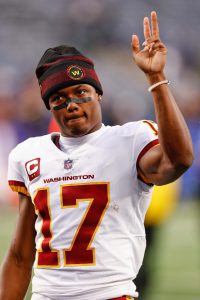
It started early in the offseason, with the team acknowledging that an extension for McLaurin was something it was interested in. McLaurin showed the team how serious he was about receiving new terms when he held out of Organized Team Activities and mandatory minicamp, racking up over $104K in fines. Reportedly, the Commanders were taken aback at the difficulties they were having reaching agreeable terms with their star receiver, and as it became clear that the two sides were very far apart on an agreement, McLaurin voiced his frustrations with the procedures.
But why has this been such a struggle? Does the team not want to lower McLaurin’s cap hit and make sure he’s around for all of the years Jayden Daniels plays on a rookie deal? It seems multiple factors are proving challenging when negotiations are taking place as performance and status say one thing, while age and potential for decline say another.
To start, McLaurin just completed his best season to date. While he didn’t put up a career high in receiving yards (1,096), his 13 touchdowns catches were more than half of his five-year career touchdown-total coming into the season (25). He also did it all in the fewest targets since his rookie year, showing improved efficiency with his new quarterback.
That’s the other thing to consider when looking at McLaurin’s career production. After falling 81 yards short of 1,000 receiving yards in his 14-game rookie campaign, McLaurin has been a 1,000-yard receiver in every season since. While that’s impressive on its own, consider that he put up consistent production while catching passes off the arms of players like Case Keenum, Dwayne Haskins, Alex Smith, Kyle Allen, Taylor Heinicke, Carson Wentz, and Sam Howell. He’s a modern-day Andre Johnson in that regard. Now that you’ve paired him with a talented, young passer, he puts up an All-Pro season.
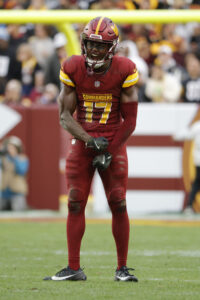 So, what does his production say he should be making on a new deal? First, let’s set the floor. Cincinnati’s Tee Higgins set the new mark for WR2s this year, surpassing Jaylen Waddle as the league’s highest-paid WR2 with an average annual value of $28.75MM. As a high-performing WR1, McLaurin should at least be making more than the highest-paid WR2. After that, the comparisons become difficult to make. The top-earning receivers market has drastically jumped in recent years with Ja’Marr Chase (AAV of $40.25MM), Justin Jefferson ($35MM), and CeeDee Lamb ($34MM) leading the pack.
So, what does his production say he should be making on a new deal? First, let’s set the floor. Cincinnati’s Tee Higgins set the new mark for WR2s this year, surpassing Jaylen Waddle as the league’s highest-paid WR2 with an average annual value of $28.75MM. As a high-performing WR1, McLaurin should at least be making more than the highest-paid WR2. After that, the comparisons become difficult to make. The top-earning receivers market has drastically jumped in recent years with Ja’Marr Chase (AAV of $40.25MM), Justin Jefferson ($35MM), and CeeDee Lamb ($34MM) leading the pack.
Age becomes a factor, as well, though. Coming in as a 24-year-old rookie, McLaurin is set to turn 30 this season. Tyreek Hill was 30 years old when he signed his most recent contract ($30MM) that gave him a $54MM signing bonus. Older receivers like 29-year-old Calvin Ridley ($23MM), 32-year-old Davante Adams ($22MM), 29-year-old Chris Godwin ($22MM), 31-year-old Stefon Diggs ($21.17MM), and 30-year-old Mike Evans ($20.5MM) hurt McLaurin’s case. D.K. Metcalf ($33MM), though two years younger that McLaurin, may have helped McLaurin’s case a bit with his recent four-year, $132MM extension in Pittsburgh.
The last point of comparison may come from his status as an All-Pro. Chase and Jefferson were both first-teamers, along with Amon-Ra St. Brown ($32MM), while joining McLaurin as second-team All-Pros were Lamb and A.J. Brown ($32MM). With the lowest AAV of those five coming in at $32MM, one would expect that to be a target for McLaurin, as well. To McLaurin’s credit, he doesn’t seem intent upon resetting the market at the position. Reasonably, he is just looking to enter the echelon of pass catchers making $30MM or more.
Ultimately, there’s so many directions in which this deal can go. We’ve focused mainly on AAV, but term length, guarantees, and fee structure can all play huge roles in negotiating that AAV up or down. McLaurin could settle for a two-year commitment in order to try and get up to $33MM or $34MM. The Commanders could try to backload base salary, while supplementing the low-salaried early years with a substantial signing bonus. There’s no shortage of predictions for how this contract may end up looking, and that’s one of the reasons why there’s been so little progress and so much frustration.
Despite the frustrations, the two sides have been in constant communication and are expected to come to terms at some point. The oft-injured Deebo Samuel can be strong while on the field, but behind him and McLaurin, the receiving corps depth is either old or unproven. Look to McLaurin’s participation in training camp, and depending on what we see, we may look for an extension in the days leading up to the regular season.
Extension Candidate: Lamar Jackson
The Ravens return 19 of 22 starters from the team they fielded in Buffalo six months ago. This is mostly good luck, as the team avoided too many expiring contracts to impact players, but that luck shifts pretty hard in the other direction in 2025 with Mark Andrews, Isaiah Likely, Tyler Linderbaum, Odafe Oweh, Travis Jones, Ar’Darius Washington, and many others heading into contract years.
All-Pro safety Kyle Hamilton will be expecting a new deal sometime soon, as well. While the Ravens will surely be working towards extension offers for many of them, there’s one player they’ve already claimed is at the forefront of their priorities for an extension. 
So many quarterbacks have gotten new deals in the last two years that Lamar Jackson‘s once-record-setting five-year, $260MM extension from 2023 feels like a distant memory. Thanks to recent new deals for Justin Herbert, Joe Burrow, Trevor Lawrence, Jordan Love, Dak Prescott, Jared Goff, Tua Tagovailoa, Brock Purdy, and Josh Allen, Jackson’s formerly league-leading $52MM annual average salary has sunk all the way down to 10th-highest in the NFL. Head coach John Harbaugh indicated at league meetings that Jackson could be back on top soon.
While it may seem counterintuitive to prioritize a Jackson extension when he still has three years remaining on his contract and the Ravens have so many players on contracts that expire sooner, getting Jackson on a new deal could serve a crucial role in helping to team to secure some of his talented teammates long-term. After this season, the final two years of Jackson’s contract have him sporting an untenable cap hit of $74.5MM. In order to help keep some of his teammates in Baltimore, Jackson and the Ravens could pursue an extension in the fashion of the man who beat him out for MVP last year.
Allen signed a six-year, $330MM extension in March despite the fact that his prior deal still had four years remaining. Instead of simply tacking on new years with more money to grant Allen his extension, the Bills essentially scrapped the terms of his original contract, giving their MVP a raise while keeping some flexibility in the team’s salary cap for years to come.
 Allen and Buffalo may have paved the way for Jackson and many quarterbacks expecting raises in the future. The Ravens could create $15.8MM of cap space in 2025 with an extension, and scrapping the terms of the original deal could help significantly lower Jackson’s cap hit in 2026 and 2027, as well. The Ravens supposedly always planned to return to the negotiation table before reaching Jackson’s obscene cap hits, and the Bills may have provided them with the perfect solution.
Allen and Buffalo may have paved the way for Jackson and many quarterbacks expecting raises in the future. The Ravens could create $15.8MM of cap space in 2025 with an extension, and scrapping the terms of the original deal could help significantly lower Jackson’s cap hit in 2026 and 2027, as well. The Ravens supposedly always planned to return to the negotiation table before reaching Jackson’s obscene cap hits, and the Bills may have provided them with the perfect solution.
One key point of difference could come in the cash and guarantee structures. Allen and the Bills chose an extremely straightforward method in which Allen’s cash receipts vary relatively little from year to year, ranging from $52.5MM to $58MM. In contrast, Jackson’s current contract saw him receive $80MM in Year 1 and $31.79MM in Year 2. In Allen’s deal, his full guarantees come from a modest signing bonus ($56.75MM), his first- and second-year base salaries, and $34.5MM of his third-year base salary. Jackson pushed hard for a fully guaranteed deal in 2023 but ended up settling for a signing bonus of $72.5MM, his first- and second-year base salaries, and some bonuses in Years 2 and 3.
It’s hard to know just how much the Ravens could follow in Buffalo’s footsteps with a Jackson deal or just how much Jackson is willing to follow in Allen’s. The team may love the structure, but Jackson may want more money up front, like with his last deal. Jackson may also see the value in spreading out his cash flow in order to ensure that the Ravens can continue to surround him with talented players.
The time is right for Baltimore to try to make something happen, before training camp and the preseason take Jackson away from the table. Regardless, they’ll need to get something done in the next nine months if they want to avoid getting stuck with one player taking up a projected 24.26 percent of the team’s salary cap space in 2026.
Extension Candidate: Trey Smith
July 15 looms as the deadline for franchise-tagged players to sign a long-term deal. In the case of 2025, that is only applicable to the Chiefs and right guard Trey Smith. 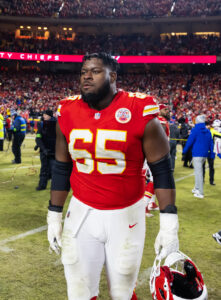
A trip to free agency appeared to be in store given the cumbersome nature of using the tag on offensive lineman. Tackles, guards and centers are grouped together for the purposes of tag calculations, which often serves as a deterrent when teams consider using it on interior blockers. The Chiefs nevertheless prevented Smith from testing the market by applying the $23.4MM one-year tender in February.
A long-term pact has represented a logical goal for both parties since well before the decision to use the tag. Smith has operated as a full-time starter during each of his four seasons in Kansas City, missing only one game to date. Given his availability concerns coming into the league, remaining healthy has been key for the 26-year-old in establishing his value.
Smith has consistently been amongst the league’s top guards during his Chiefs tenure. The Pro Bowler has ranked between 10th and 15th each season in terms of PFF grade, and he will be expected to remain a strong contributor up front for years to come if a multi-year Kansas City pact can be worked out. The team traded away All-Pro guard Joe Thuney this offseason in a move which freed up money but also signaled an investment in Smith (who is six years younger) would be coming.
Indeed, Chiefs general manager Brett Veach said in April a long-term deal on this front was among his top post-draft priorities. In the months since then, few updates have emerged suggesting the sides are close to an agreement. As the deadline approaches, though, that could of course change in short order.
 At the moment, the value of Smith’s fully guaranteed tag is set to match his 2025 cap hit. That figure is the highest for interior O-linemen, but it would be reduced with a long-term pact. The guard market currently includes four players attached to an AAV over $20MM on a multi-year accord, with Landon Dickerson leading the way at $21MM. Smith could certainly look to join that group given his performances, age and the jump in the salary cap since the other deals were signed.
At the moment, the value of Smith’s fully guaranteed tag is set to match his 2025 cap hit. That figure is the highest for interior O-linemen, but it would be reduced with a long-term pact. The guard market currently includes four players attached to an AAV over $20MM on a multi-year accord, with Landon Dickerson leading the way at $21MM. Smith could certainly look to join that group given his performances, age and the jump in the salary cap since the other deals were signed.
Kansas City already has center Creed Humphrey on the books at an average of $18MM per season (the most at that position). Right tackle Jawaan Taylor also has a notable cap number for the year, although he is not assured of a starting spot this season. The left side of the team’s line, meanwhile, will be the subject of considerable scrutiny as the prospect of first-round rookie Josh Simmons handling blindside duties right away is considered.
Regardless of how that shakes out, Smith will be counted on to remain an anchor up front. Improvement in terms of both run blocking and pass protection will be a key goal for Kansas City in 2025 irrespective of Smith’s contract status. Well before Week 1, however, it will be known if he has a contract beyond the coming campaign.
Extension Candidate: Mike Evans
Despite missing three full games due to injury in 2024, Buccaneers wideout Mike Evans completed his mission of topping 1,000 receiving yards in each of his first 11 seasons in the NFL. The six-time Pro Bowler and franchise icon is entering the final year of the two-year, $41MM contract he signed in March 2024, and he therefore profiles as an obvious extension candidate.
However, prior to putting pen to paper on his current pact, Evans appeared to be on track to hit the open market, and he considered the Chiefs and Texans to be viable destinations if he had become a free agent and left Tampa. So, while it is difficult to imagine Evans in anything other than a Bucs uniform, he has at least entertained the notion in recent history.
That reality, combined with his age (he will turn 32 next month) and the Bucs’ heavy investment in the WR position could lead Evans elsewhere in 2026. Indeed, Tampa Bay re-upped Chris Godwin on a three-year, $66MM deal before free agency opened this year, and the club surprised many by adding Ohio State standout Emeka Egbuka in the first round (No. 19 overall) of this year’s draft. Jalen McMillan was selected in the third round of the 2024 draft, and he flashed as a rookie, securing 37 catches for 461 yards and eight scores.
On the other hand, newly-extended GM Jason Licht has made a habit of retaining his own talent. And, with the Bucs firmly in the midst of a competitive window, there is certainly an argument to be made for retaining Evans, who has continued to be productive into his early 30s.
That is especially true in light of the fact that Godwin has operated primarily in the slot since becoming a full-time starter in 2019 (outside of Dave Canales’ one-and-done season as offensive coordinator in 2023). Egbuka likewise spent most of his college career working out of the slot, so even with multiple high-end contracts and premium draft picks populating the wide receiver depth chart, Evans’ skill set as a dangerous boundary target is hardly redundant.
Plus, the use of void years in Evans’ current deal will force the Bucs to eat over $13MM in dead money if he is not on the roster next year. When talking about possible Olympic participation in 2028, Evans said he would likely be retired by that point, which suggests he plans to keep playing for at least the 2026-27 campaigns. As such, a two-year add-on would make plenty of sense for both sides, and as the Bucs presently sit in the top half of the league in terms of cap space ($26.53MM), they seemingly have the flexibility to make it work (although quarterback Baker Mayfield may be eyeing a new contract and substantial raise next year).
Regardless of where his next contract comes from, Evans stands to add considerably to his ~$134MM in career earnings, which positions him in the top-15 among active non-quarterbacks. He also has an excellent chance to bolster his Hall of Fame candidacy over the next several years.
Although he is currently in 24th place on the all-time receiving yards list (12,684), Evans can quickly catapult up that index of luminaries if he can sustain what has become ordinary output for him. By the time the 2027 season is in the books, it would not be surprising to see him in the top-five in terms of receiving yards (Isaac Bruce presently sits at No. 5 with 15,208) and receiving touchdowns (Marvin Harrison Sr. and his 128 TDs are in fifth place in that regard, while Evans leads the way among all active players with 105 receiving TDs).
In addition to his tremendous 17-game average triple-slash of 85/1,284/11, Evans has never played in fewer than 13 games in a season. There have been no reports of extension talks yet, but one would imagine that Licht & Co. are at least giving it some thought.
Extension Candidate: Zach Allen
A central reason the Broncos were able to make the playoffs despite the record-shattering Russell Wilson dead money bill, Zach Allen has played his best football since relocating to Denver in 2023. The short-term J.J. Watt Cardinals sidekick has been one of the NFL’s most disruptive interior D-linemen in two Broncos seasons.
Allen signed a three-year, $45.75MM contract on Day 1 of the 2023 legal tampering period, following Ben Powers and Mike McGlinchey as part of Sean Payton‘s aggressive transactional start to his Broncos tenure. While McGlinchey and Powers are respectively on five- and four-year deals, Allen is in a contract year. The former Cardinals third-round pick, who entered the NFL in Vance Joseph‘s first Arizona offseason, resides in a good position to cash in.
[RELATED: Top 2025 Salary Cap Hits For Defenders]
 Allen recorded a whopping 40 QB hits last season; that not only led the NFL in 2024, it ranks near the top among modern pass-rushing seasons. Throughout the 2020s, only Nick Bosa‘s 2022 (48) and T.J. Watt‘s 2020 (41) delivered more QB hits than Allen’s 2024 brought. Even if the range is moved to cover the past 10 seasons, Allen’s 2024 showing still ranks eighth (J.J. Watt‘s peak was quite good). Allen also tallied 47 QB pressures last season; only Trey Hendrickson (54) produced more at any position.
Allen recorded a whopping 40 QB hits last season; that not only led the NFL in 2024, it ranks near the top among modern pass-rushing seasons. Throughout the 2020s, only Nick Bosa‘s 2022 (48) and T.J. Watt‘s 2020 (41) delivered more QB hits than Allen’s 2024 brought. Even if the range is moved to cover the past 10 seasons, Allen’s 2024 showing still ranks eighth (J.J. Watt‘s peak was quite good). Allen also tallied 47 QB pressures last season; only Trey Hendrickson (54) produced more at any position.
A spring report pointed to Allen and Nik Bonitto being higher Broncos extension priorities compared to Courtland Sutton, who has been waiting for a deal longer. This is Bonitto’s first offseason of extension eligibility. Having spent his entire career in Joseph’s scheme, Allen represents a fairly safe bet for the Broncos. Going into only his age-28 season also represents a plus here, whereas Sutton will turn 30 in October. Allen has also expressed interest in a Broncos extension.
It can be argued Allen’s presence catalyzed Bonitto’s breakout. Both players zoomed to second-team All-Pro status, as Bonitto broke through for 13.5 sacks. Allen’s 8.5-sack total does not jump out as much, even with a Week 1 safety also landing on his resume, though Bonitto’s pressure numbers (36 to go with 24 hits) were not on the interior rusher’s level. Bonitto heading into his age-26 season will help his cause, but the Broncos also have the franchise tag to use in 2026.
Wilson’s punitive dead money penalty ending in 2025 would free up a tag slot for next year, and Bo Nix must remain on a rookie contract through at least 2026. Denver has John Franklin-Myers as a more affordable extension option in a contract year, and the team traded up for 3-4 DE Sai’Vion Jones in Round 3. It would seem unlikely, though, that the franchise — one set to rely on a top-tier defense once again — would chance moving on from Allen after one contract given his recent form and experience under Joseph.
The Broncos will be looking at a sizable raise here, as the defensive tackle market has moved twice since Allen’s March 2023 accord. As a second tier formed behind Aaron Donald‘s outlier deal in the spring and summer of 2023, four players (Daron Payne, Dexter Lawrence, Jeffery Simmons, Quinnen Williams) scored extensions between $22.5MM and $24MM per year. Chris Jones then used Donald’s deal as a springboard to gouge the Chiefs two days before the 2024 tampering period. Jones lifted the DT spot’s ceiling to $31.75MM per year and $60MM guaranteed at signing. Capitalizing on a Jones-less market, Christian Wilkins landed $27.5MM per year and $57MM at signing from the Raiders in 2024.
 This year, Milton Williams became the NFL’s third-highest-paid interior D-lineman by commanding $26MM per year and $51MM at signing from the Patriots. Williams is nearly two years younger than Allen, but the ex-Eagle has not produced a season on the latter’s level. Even Allen’s 2023 featured 24 QB hits and 27 pressures. He has never been a sack maven, having tallied more than 5.5 just once. Williams’ next 5.5-sack season will be his first, however, while Wilkins and Nnamdi Madubuike each delivered outlier sack seasons in their 2023 contract years. Wilkins was also 28 when he signed his big-ticket Las Vegas deal.
This year, Milton Williams became the NFL’s third-highest-paid interior D-lineman by commanding $26MM per year and $51MM at signing from the Patriots. Williams is nearly two years younger than Allen, but the ex-Eagle has not produced a season on the latter’s level. Even Allen’s 2023 featured 24 QB hits and 27 pressures. He has never been a sack maven, having tallied more than 5.5 just once. Williams’ next 5.5-sack season will be his first, however, while Wilkins and Nnamdi Madubuike each delivered outlier sack seasons in their 2023 contract years. Wilkins was also 28 when he signed his big-ticket Las Vegas deal.
Hitting free agency helped Wilkins and Milton Williams, and Allen could certainly bet on himself and do well in 2026. (Though, he will be negotiating ahead of an age-29 season in that scenario.) The Broncos will undoubtedly work to prevent that from happening, but even as the seventh-year vet can only negotiate with one team for the time being, that Payne-Lawrence-Simmons-Quinnen Williams tier should be a reasonable floor.
That is a steep hike from $15.25MM AAV, but the salary cap has ballooned from $224.8MM to $279.2MM since those 2023 extensions commenced. Allen’s camp will likely cite the Wilkins and Milton Williams deals as comps, making the previous DT second tier a logical compromise.
The Broncos extended four players — Quinn Meinerz, Patrick Surtain, Jonathon Cooper and Garett Bolles — between July 16 and December 12 last year. GM George Paton also paid Sutton in-season back in 2021, and a potential in-season Bonitto payday could be on track. The Broncos will surely ramp up discussions with their top two front-seven pieces before Week 1. Carrying a high-pressure/modest-sack resume, Allen’s negotiations will be a key storyline to follow as the Broncos attempt to firmly establish themselves as contenders after last season’s surprising playoff trek.
Extension Candidate: Tyler Linderbaum
The Ravens declined the fifth-year option of center Tyler Linderbaum in May, making 2025 a contract year for the 2022 first-round pick.
 Typically, that decision means that a team doesn’t want to sign a player to a long-term extension. The Ravens, for example, didn’t pick up Patrick Queen‘s fifth-year option in 2023 and let him walk in free agency the following year.
Typically, that decision means that a team doesn’t want to sign a player to a long-term extension. The Ravens, for example, didn’t pick up Patrick Queen‘s fifth-year option in 2023 and let him walk in free agency the following year.
Linderbaum’s situation is a little different. The NFL calculates fifth-year option values based on the top salaries at each position, but the formula groups all offensive linemen together. With two Pro Bowls under his belt, Linderbaum’s fifth-year option reached the highest tier at $23.4MM; effectively, the Ravens would have been paying their starting center like a premium left tackle in 2026. That figure would have also set a high bar in long-term contract talks as players rarely sign extensions with an average value below their fifth-year option.
As a result, a new deal for Linderbaum is still firmly in play in the coming months. The Ravens confirmed as much in a statement when they announced their fifth-year option decisions, though general manager Eric DeCosta said the same thing about Queen on a team podcast in 2023. At that time, the Ravens had recently traded for Roquan Smith and used a third-round pick on Trenton Simpson, but this year, they have no clear successor for Linderbaum on the roster. (A franchise tag for 2026 is likely out of the question. Thanks to the same positional designation quirk, Linderbaum is projected by OverTheCap to cost $24.7MM on the transition tag and $27.603MM on the franchise tag.)
Even if Baltimore could find a replacement by next season, he likely will not offer the same elite level of play as Linderbaum. The 25-year-old center has been one of the league’s best since he was drafted in 2022 with the No. 25 pick, which the Ravens acquired as a result of the Marquise Brown trade. Linderbaum immediately stepped in as Lamar Jackson‘s starting center and put together a solid rookie year before making a leap in 2023 after the arrival of offensive coordinator Todd Monken.
Improvements in Linderbaum’s anchor in pass protection and Monken’s creative use of his athleticism in the run game has brought out the best in Linderbaum over the last two seasons. In that time, he reached two Pro Bowls and hasn’t allowed a single sack, per PFF (subscription required), and the Ravens have dominated opponents on the ground.
 The former Iowa Hawkeye has also been durable in his career thus far, starting 54 of the Ravens’ 56 games since he was drafted (including the postseason). Jackson struggled with consistency at center before Linderbaum’s arrival in 2022, so the team has reason for wanting to lock the position down for the foreseeable future.
The former Iowa Hawkeye has also been durable in his career thus far, starting 54 of the Ravens’ 56 games since he was drafted (including the postseason). Jackson struggled with consistency at center before Linderbaum’s arrival in 2022, so the team has reason for wanting to lock the position down for the foreseeable future.
Given Linderbaum’s pedigree and durability, an extension is likely predicated on making him the highest-paid center in the NFL. Currently, that title belongs to the Chiefs’ Creed Humphrey, who signed a four-year, $72MM deal last August with $35MM guaranteed at signing and $50.315MM in total guarantees, per OverTheCap. That should get Linderbaum above $18MM per year with a commensurate increase in guaranteed money.
He may even push to join the ranks of the highest-paid interior offensive linemen with the guard market above $20MM per year. That may prove difficult for the Ravens, who are working on an extension for Jackson with several other key players in the last year of their contracts. Baltimore would likely prefer to make Linderbaum the league’s most expensive center at a more symbolic $18.25MM or $18.5MM APY rather than resetting the market at $19MM or more. They could rely on a familiar strategy to accomplish that.
DeCosta has kept a lid on the team’s major contracts by offering significant guarantees at signing in exchange for a discount on APY. For example, Ronnie Stanley could have signed for more than $20MM per year on the open market, but he took $60MM over three years from the Ravens, in part because his $44MM in fully guaranteed money ranks third among NFL left tackles.
As a result, a four-year, $74MM extension with a stronger guarantee structure than Humphrey’s deal could offer a middle ground between Linderbaum and the Ravens. He has been present for all but one practice during Baltimore’s OTAs, indicating that he has no intention of holding out (or in) this year as the team works on a new contract.
Extension Candidate: Garrett Wilson
The NFL’s wide receiver market hit a new high-water mark this offseason with Ja’Marr Chase receiving $40.25MM per year from the Bengals less than a year after Justin Jefferson became the first WR to reach a $35MM APY. D.K. Metcalf also negotiated a strong deal with the Steelers worth just under $33MM per year.
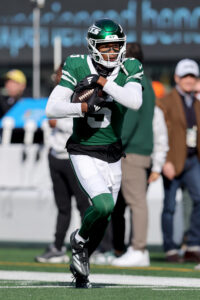 A rising tide lifts all boats, so the boom in wide receiver pay should benefit a talented 2022 draft class that became extension-eligible this offseason. Leading the pack with 279 receptions for 3,249 yards in the last three season is former No. 10 pick Garrett Wilson, who has started negotiating a long-term deal with the Jets.
A rising tide lifts all boats, so the boom in wide receiver pay should benefit a talented 2022 draft class that became extension-eligible this offseason. Leading the pack with 279 receptions for 3,249 yards in the last three season is former No. 10 pick Garrett Wilson, who has started negotiating a long-term deal with the Jets.
Wilson has been New York’s top receiver since he joined the team and projects to play a foundational role in their new offense under offensive coordinator Tanner Engstrand. Wilson will also reunite with Ohio State teammate Justin Fields and should be his most trusted target off the bat with little competition for targets. That could position the 24-year-old receiver for a strong 2025 that could significantly raise his price tag if the Jets don’t get an extension done before the season.
Right now, negotiations will likely start around $30MM per year, the low end of the NFL’s WR1 market. Brandon Aiyuk, Tyreek Hill, and Amon-Ra St. Brown are making the same amount, per OverTheCap, and five more wideouts have an APY of $32MM or more.
Wilson seems to belong to the first group. He ranks eighth in receptions and 10th in receiving yards among WRs since 2022 with at least 1,000 receiving yards in each year. However, his career-best 2024 numbers don’t come close to Aiyuk, Hill, or St. Brown in their best seasons, so Wilson may have trouble arguing that he deserves a bigger contract than all three. Though he won Offensive Rookie of the Year in 2022, he has yet to receive Pro Bowl or All-Pro recognition, another factor that will likely keep him from a top-dollar deal.
Wilson can still construct a strong case out of his age, durability, and adaptability and argue that he’s an ascending player who has yet to play his best football. He will turn 25 this year after appearing in all 51 of the Jets’ regular-season games since being drafted despite his slight 185-pound frame. He has also demonstrated clear growth into a WR1 role with 83, 95, and 101 receptions in his first three years with noticeable improvements at the catch point last season. (Wilson posted a 56.5% catch rate in 2022 and 2023; in 2024, it jumped to 65.6%.)
 However, Wilson has not been especially efficient in the pros. He ranks 19th among all WRs in yards per game (63.7) since 2022 with a pedestrian 6.93 yards per target. He has also struggled to reach the end zone with just 14 career touchdowns on 469 targets.
However, Wilson has not been especially efficient in the pros. He ranks 19th among all WRs in yards per game (63.7) since 2022 with a pedestrian 6.93 yards per target. He has also struggled to reach the end zone with just 14 career touchdowns on 469 targets.
Advanced metrics from Pro Football Focus (subscription required) tell a similar story. Wilson’s 51.7% contested catch rate in 2024 was a career-high, but only ranked 20th among receivers with at least 85 targets. His 1.69 yards per route run ranked 32nd in that same group, though he did lead all WRs with 25 missed tackles forced after the catch.
Wilson’s production alone would likely place his next contract just outside the top 10 at his position (and therefore under $30MM per year), but context is important. The Jets’ offense around him has been terrible with three straight bottom-10 finishes in yards per game, according to Brian Costello of the New York Post. Costello also pointed out that Wilson has caught passes from eight different quarterbacks on plays called by three different coaches; his best passer was a clearly aging Aaron Rodgers in 2024 playing some of the worst football of his career. (It’s still worth noting that Wilson’s production remained largely the same with Rodgers under center, partially due to expanded competition for targets from Davante Adams.)
Fields certainly isn’t a more proven quarterback than Rodgers, but he already has a rapport with Wilson that Rodgers was never able to establish. Wilson should also benefit from Engstrand’s schematic influence after he coached Amon-Ra St. Brown and Jameson Williams to breakouts in his last role as the Lions passing game coordinator.
As a result, a long-term contract in the neighborhood of $30MM per year could end up looking like a steal if Wilson takes his game to the next level in 2025. He may recognize that and adjust his demands accordingly, but the Jets have some leverage after picking up his $16.8MM fifth-year option for 2026. Wilson cannot earn more than $20MM in the next two years unless he signs a long-term extension, which should also come with upwards of $50MM in guaranteed money. The former first-round pick may still choose to bet on himself with the hopes of breaking into the upper echelon of WR contracts next offseason.
Extension Candidate: Nik Bonitto
As the Broncos reconstructed their pass-rushing corps following the Von Miller trade, high-profile veterans Bradley Chubb and Randy Gregory headlined the team’s depth chart. Baron Browning and fellow Ohio State alum-turned-2021 Broncos draftee Jonathon Cooper loomed as rotational pieces as well. The team’s plans changed fairly quickly to start its first post-Miller season.
Denver traded Chubb for a big haul, collecting first- and fourth-round picks from the Dolphins for the 2018 first-rounder. The team, which had dealt two firsts and six more assets to the Seahawks for Russell Wilson, then sent that first to the Saints for Sean Payton‘s rights. Immediately coming in as the lead decision-maker in Denver, Payton bailed on Gregory and has since traded Browning — a 2021 third-rounder. That trade with the Cardinals came days after the Broncos extended Cooper at what looks like a team-friendly rate, considering what the emerging edge defender could have made if he tested the 2025 free agent market.
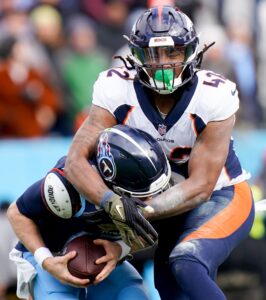 While Cooper’s four-year, $54MM deal locks the seventh-round success story in through 2028, the Broncos’ other OLB starter has become one of the NFL’s top 2024 breakthroughs. Chosen with the second-round pick obtained from the Rams in the Miller trade, Nik Bonitto has produced a season that will price him well north of the range into which Cooper settled. Eligible for an extension next month, the third-year EDGE will provide an interesting case for a Broncos team that is both building around a rookie-quarterback contract while still paying the penalty for its previous QB mistake.
While Cooper’s four-year, $54MM deal locks the seventh-round success story in through 2028, the Broncos’ other OLB starter has become one of the NFL’s top 2024 breakthroughs. Chosen with the second-round pick obtained from the Rams in the Miller trade, Nik Bonitto has produced a season that will price him well north of the range into which Cooper settled. Eligible for an extension next month, the third-year EDGE will provide an interesting case for a Broncos team that is both building around a rookie-quarterback contract while still paying the penalty for its previous QB mistake.
Coming to Denver as a pass rush specialist deemed a work-in-progress against the run, Bonitto has delivered the Broncos’ first double-digit sack season since Miller and Chubb both did so in 2018. The Broncos kept seeing injuries derail further efforts to deploy Miller and Chubb together, but thus far, Bonitto and Cooper have been catalysts for the team’s defensive turnaround. With Cooper locked in, the focus will shift to Bonitto, whose rookie contract runs through next season.
Bonitto’s 11.5 sacks are tied for fourth in the NFL; the Oklahoma alum’s 20 QB hits match his full-season total from 2023. Bonitto’s 32 pressures are tied for 11th leaguewide. The improved defender also has memorably produced two defensive touchdowns, recording a pick-six against the Browns and then snatching a backward pass — on a slow-developing Colts trick play — and adding a second score. While Bovada gives Patrick Surtain the only realistic chance to overtake T.J. Watt as Defensive Player of the Year, Bonitto sits third among the odds for this award.
For a Broncos team that made three of this century’s worst personnel decisions (hiring Nathaniel Hackett as HC, trading for Wilson and then extending him), Bonitto has provided a vital spark — particularly with regards to GM George Paton‘s job status. Continuing to fight off rumors he might be jettisoned, Paton has given the now-Payton-led team integral pieces via the draft. Bo Nix obviously headlines the Broncos’ roster right now, but Surtain, Bonitto, Cooper and Quinn Meinerz have been important pieces to the team turning its operation around despite carrying a staggering $90.1MM in dead money.
Paton has extended Surtain, Meinerz, Cooper and John Elway-era draftee Garett Bolles this year. Bonitto’s 2024 season may be good enough that the Broncos cannot realistically entertain not paying him by 2026. The franchise tag could come into play for the former No. 64 overall pick at that point, as Bonitto’s value has climbed to an interesting place. But the Broncos would be wise to engage in earlier extension talks with their top pass rusher.
 Cooper’s deal only made him the league’s 22nd-highest-paid edge rusher. It would seem unrealistic the Broncos could present Bonitto an offer outside the top 10 in that market. Anything beyond the top five ($25MM AAV and up) may also be a stretch, as both Brian Burns and Josh Hines-Allen each reached $28MM per year on their 2024 extensions. Those pacts rank second and third among edge players, and the market will change soon.
Cooper’s deal only made him the league’s 22nd-highest-paid edge rusher. It would seem unrealistic the Broncos could present Bonitto an offer outside the top 10 in that market. Anything beyond the top five ($25MM AAV and up) may also be a stretch, as both Brian Burns and Josh Hines-Allen each reached $28MM per year on their 2024 extensions. Those pacts rank second and third among edge players, and the market will change soon.
Fireworks are also likely coming in this market next year, with the likes of Watt, Myles Garrett, Micah Parsons and Trey Hendrickson entering contract years. Bonitto would be wise to wait to see what the market looks like late next summer, while the Broncos would be better off making an early move — as they did with Surtain this summer — and paying their ascending OLB before the top of the market changes.
The team took on the bulk of the Wilson dead money this year, carrying $53MM in dead cap on its payroll, but $30MM-plus is due to hit next year. That undercuts a Broncos effort to capitalize on Nix’s rookie deal. The Broncos’ 2026 cap sheet will look a bit better, with Nix still on rookie terms and Wilson’s contract removed from the equation, but a Bonitto extension — assuming Nix’s upward trajectory continues — would stand to overlap with a monster QB extension by the late 2020s. That would be a good problem for a Broncos team that whiffed many times trying to replace Peyton Manning, however.
Surtain and four of the team’s five offensive line starters are all now signed through at least 2026. Courtland Sutton and D-lineman Zach Allen‘s contracts go through 2025. Like Nix and this contingent, Bonitto has established himself as a core performer. When his extension talks start will be a key Broncos storyline to monitor during the upcoming offseason.

